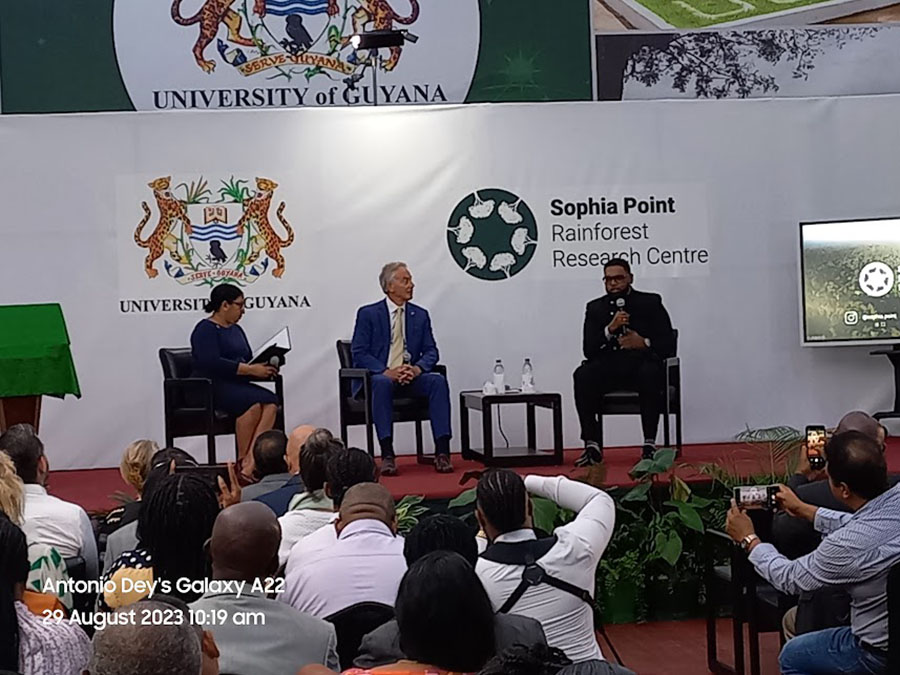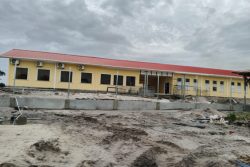As climate change continues to remain a pressing global challenge, President Irfaan Ali yesterday reminded of the responsibilities vested upon global leaders to devise feasible solutions to this issue and played up Guyana’s forest credentials.
“That is why today we have one of the lowest deforestation rates in the world, which gives us a good international branding because having a forest that can contribute positively to humanity and the climate change equation is laudable,” Ali noted.
Ali, who was speaking at the launch of the Sophia Point Research Centre, zeroed in on the dual pursuit of financing development while protecting the environment. According to him, governments have that responsibility to their citizens, as such, they must find ways to earn enough to support development.
During a conversation between the President and visiting former Prime Minister of the United Kingdom, Tony Blair, Melinda Pollard, the Toshao of River’s View (Region 10), asked how the government plans to manage the equitable disbursement of carbon credits to indigenous communities including those who are not surrounded by rainforests. Ali said that the carbon- credits strategy does not exclude any indigenous community since rainforests are of cultural and environmental significance to Guyana’s Indigenous Peoples.
Back in December 2022, the Government of Guyana entered into an agreement with Hess Corporation for the sale of carbon credits for a minimum of US$750 million between 2022 and 2032. The first deposit of US$75 million represents: US$37.5 million for 2.5 million ART-TREES credits from 2016 at a price of US$15/tonne of CO2e; and US$37.5 million for 2.5 million ART-TREES credits from 2017 at a price of US$15/tonne of CO2e. Ali reminded that 15% of the monies from Hess Cor-poration will go towards Indigenous communities.
Two university students also asked the President for an update in relation to Guyana’s role in addressing climate change and Ali referenced his government’s ongoing progress in achieving the 2030 Low Carbon Development Stra-tegy. Guyana, he said, plans to attend the upcoming United Nations’ climate change talks – COP28 – in Dubai to demonstrate how it has sustainably managed its forests and how it has been able to balance oil production through its Low Carbon Development Strategy (LCDS).
While Guyana has a low deforestation rate, critics point to its decision to utilise natural gas to produce energy as a climate-unfriendly act. It is also on a policy of accelerated extraction of hydrocarbons which will release even more climate-warming gases.
Former British Prime Minister Blair, who also spoke, said Guyana must adopt the Climate Change Financing Framework (CCFF) in order to achieve its goals of low carbon emissions and climate change resilience. The CCFF identifies sources of climate finance and poten-tial trends over the next five to ten years and uses the estimate to propose a realistic costing of the country’s climate change response. Guyana and other countries have lobbied for a global system that pays for keeping their forests intact. Norway was the first to buy in to Guyana’s forests, signing a deal for USS$250 million, once deforestation rates remained below target.
Guyana’s LCDS 2030 sets out an updated vision for how the government intends to drive the transformation of the country, highlighting the finances that can be accrued for its under 1% deforestation. The LCDS 30 document outlines how Guyana can earn payments. “Earning payments as Guyana moves towards a market mechanism will involve: (i) integrating with the market standard; (ii) generating credits in accordance with that standard; (iii) marketing Guyana’s credits to potential buyers,” it states.
Appendices 1 and 2 of the document describe credit generation and the methodology for calculating those credits, but says “in sum, Guyana will receive credits for (i) any reductions in deforestation against the previous five-year average (starting with 2016-2020 as the reference period); (ii) restoration of deforested or degraded forest; (iii) the long-term storage of carbon in Guyana’s standing forest, providing that Guyana’s deforestation rate does not increase significantly above historic averages.” The one-hour discussion on climate change was moderated by UG Vice Chancellor Dr. Paloma Mohamed Martin.
Sophia Point Rainforest Centre
Also at the UG Turkeyen Campus, yesterday, UK Parliamentarian, David Lammy and his wife, Nicola Green, unveiled the new Sophia Point Rainforest Centre, geared at providing platforms for students to study vital ecosystems, biodiversity and promote the protection and preservation of rainforests. The non-profit centre, which will be situated at the confluence of the Cuyuni, Mazaruni and Essequibo rivers, will also provide access to young Guyanese to study the rainforest and empowering them to become the young leaders of tomorrow. Lammy, who is of Guyanese heritage, said this initiative serves as his lifelong vow to give back to Guyana, as the centre was necessary to add to forest research and conservation efforts done through the Iwokrama Research Centre in Guyana.
“If you look around the globe to comparable countries, you can see what the standard is, Costa Rica, which is four times smaller than Guyana, has 44 research stations,” he pointed out. Similarly, Panama, a country three times smaller than Guyana, has about 12 interconnected sites managed by the world’s largest museum, education, and research complex. Lammy posited that research must be a crucial part of forest conservation efforts, as is reflected in Guyana’s Low Carbon Development Strategy (LCDS), but emphasized that local capacity must be prioritized. On that note, he said, the centre will work with the nearby River’s View Indigenous community and more broadly, Guyana’s academia.
Lammy declared that the centre will not be a space for foreign researchers to extract Guyana’s knowledge. “It is not about western scientists flying into Guyana and flying out of Guyana, taking the science out of Guyana. We want to bring an end of that extractive model,” Lammy said. And if these plans are executed as envisioned, the UK Parliamentarian believes that more Guyanese youth can be inspired to help protect the environment.
“It’s a space for young Guyanese to be inspired and inspire others to better protect the vital rainforest and to equip themselves with the knowledge and the skills to inspire generations to come,” the UK Parliamentarian said. Sophia Point will be the first of its kind, a truly accessible wildlife and rainforest research centre in Guyana.
Work is now underway to construct a low-impact, purpose-built centre on the site. This will accommodate up to 24 students or researchers and provide the gateway to some of the least studied rainforest on the planet. This will pave the way for local-led, world leading research at Sophia Point.









